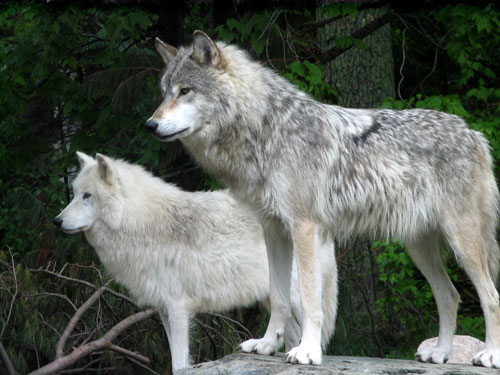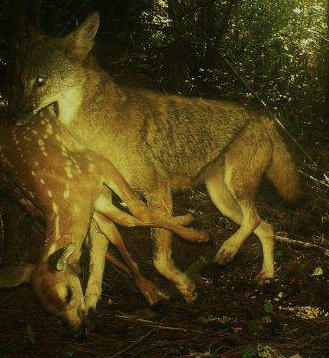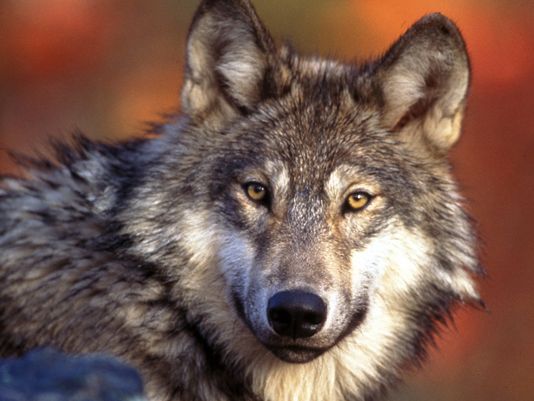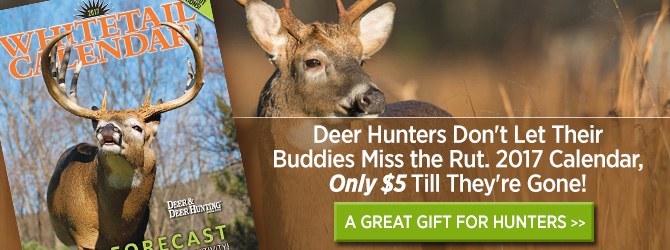
Despite their inherent behavioral differences, gray wolves and coyotes share one common dietary interest: white-tailed deer.
Where they coexist, at least on Northern ranges, venison serves as the primary winter food for wolves and coyotes. Its availability may ultimately determine whether populations of both predators flourish or fail.
Generally speaking, wolves are more adept at capturing adult deer whereas coyotes are more proficient at finding and killing newborn fawns. Coyotes also tend to be more omnivorous — meaning they eat vegetable as well as animal materials — and tend to rely on scavenging deer remains, whereas wolves are more inclined to seek live prey.
Needless to say, if they could compatibly share the same range, wolves and coyotes would make a deadly deer-killer team. The important question is, of course, since wolves also kill coyotes when given the chance (just as coyotes kill foxes), can the two canids coexist? Or, as wolves re-establish themselves, and become more socially organized, as they appear to be doing, will they gradually crowd-out coyotes?
Although some biologists might argue the point, the best evidence indicates that the relative abundance of all three species — predators and prey — has declined during the past 10 years or so throughout the Northern Great Lakes region. Determining reasons for such possible trends are even more arguable.
A HISTORY LESSON
The coyote was originally an animal of the Western prairie, before the white man arrived with ax and plow. Since then, it has greatly extended its range — in spite of man’s traps, guns and poisons. Indeed, man’s past failed efforts to control coyotes seems to have created a “super coyote.”

In fact, pioneer ecologist Stanley P. Young suggested it may have been man’s persecution that encouraged the coyote’s spread through the centuries.
Today, coyotes can be found from well into Central America to near Point Barrow, Alaska, eastward to Hudson Bay, New Brunswick, Maine, and across most of the Western and Midwestern United States. Most recently, coyotes also have invaded the Southeast, where they are now abundant and their presence highly controversial.
Gray wolves, on the other hand, have not fared so well in the presence of man. This canid occurs throughout the Arctic and formerly occurred southward throughout the United States (except for the Southeast) and into Mexico. However, man extirpated wolves from almost all of the southern part of its North American range by the early to mid-1900s.
Due largely to improving habitat, human tolerance, reintroductions and a number of contributing factors we don’t fully understand, wolves have made an impressive comeback during the past couple of decades across portions of their former southern range.
For example, according to Michigan DNR wildlife biologist Kevin Swanson, there were only three wolves in the Upper Peninsula (UP) of Michigan in 1989. Today, there are a little more than 600 wolves in the UP. About the same number have been tallied in northern Wisconsin and they are doing even better in northern Minnesota. In addition, wolves recently reintroduced to areas such as Yellowstone National Park seem to be thriving.
It’s important to recognize, however, that newly introduced or recovering mammal species typically achieve artificially high numbers only to decrease somewhat later and level-off at lower densities. Even white-tailed deer living in southern parts of Michigan’s UP have recently exhibited this phenomenon, going from low densities in the 1960s to ridiculously high densities (100 deer or more per square mile) in some areas during the 1990s, to sharply reduced numbers in recent years.
As wolves disappeared in the past, coyotes quickly moved in to occupy the vacated range. Now, the reverse seems to be taking place; wolves are moving in to reclaim range coyotes have occupied for the past 100 years or more.
Some biologists support the view that wolves will replace coyotes in certain areas. Others suggest the “clever coyote” will prevail and learn to coexist with wolves. There is scientific evidence to support both views.
WATCH: TIPS ON PREDATOR MANAGEMENT FOR BETTER DEER HUNTING
THE ISLE ROYALE STORY
Historically, wolves may have played an important role in replacing coyotes on Isle Royale, located at the west end of Lake Superior. In less than 60 short years, the coyote arrived on Isle Royale, prospered for a time, declined, then disappeared altogether. Coyotes probably reached Isle Royale by traveling over the ice from the Sibley Peninsula region of Ontario, a distance of 15 miles, in about 1906. (This is about the same time coyotes were first observed in Michigan’s UP.) Despite the less than favorable habitat for them, coyotes flourished on the island, reaching peak numbers of about 150 animals in 1948.
Coyote numbers on Isle Royale began to decline starting in 1949, about the time wolves reached the island. The decrease in coyote numbers also came with a crash decline in the beaver population, a die-off of moose, and a low snowshoe hare population. Coyotes disappeared from Isle Royale in 1957 or 1958, probably due to a reduced food supply and direct killing by wolves.
Interestingly, Isle Royale wolves have followed that same boom and bust pattern. Today, there are only two wolves left on the island, and biologists face the same dilemma they did nearly 100 years ago: Introduce more wolves or watch the expanding moose herd devastate island vegetation.
COYOTE-WOLF INTERACTIONS
In Manitoba, Canada, researcher Ludwig Carbyn observed that wolves frequently killed coyotes but did not eat them. He found no evidence that coyotes avoided wolves during most of the year, but definitely did so from mid- to late-winter.
Carbyn theorized that differences in snow conditions, and learning on the coyote’s part, might be involved in the coyote’s changing response to wolves as the winter progressed. When snow is deep and soft, coyotes are hindered more than wolves. However, since coyotes often trailed wolves through deep soft snow, Carbyn rationalized although coyotes might avoid wolves after a “refractory period,” they might actually trail them at a safe distance in search of food.

Since wolves are territorial and might even kill their own kind when boundaries are trespassed, buffer zones exist between wolf territories where few wolves travel. Coyotes (and even whitetails) sometimes find these buffer zones safe havens. In Carbyn’s study, coyotes were not always safe from wolves while in the buffer zone when wolf density was high. However, overall coyote survival appeared to be greater there during years of only moderate wolf density.
In another Manitoba study, researchers found coyotes scavenging wolf-killed deer within 24 hours after abandonment by wolves. Although wolves occasionally killed coyotes, the investigators found no evidence of wolves actively searching for coyotes. Neither was there any evidence that coyotes adjusted their movements to avoid wolves.
In areas where elk serve as the major winter food for both wolves and coyotes, wolves tend to kill the elk while coyotes scavenge the remains. Because predation on large prey, such as elk, involves considerable risk of injury and is likely energetically expensive owing to a low rate of success, there is no apparent advantage in killing prey if coyotes have a good quality food that can be scavenged. However, it may be a different story when both predators must exist primarily upon smaller prey such as deer.
If deer are the preferred prey, then coyotes lose the opportunity to scavenge wolf kills because wolves prey- ing on deer leave few remains — at least during most winters.
Findings from studies conducted by Minnesota researcher Glen DelGuidice add a new twist to this story. Apparently, during especially severe winters (i.e., deep snow for four to eight weeks), wolves exhibit surplus killing of deer with no or low consumption of the carcass. Under such conditions wolves might kill many more deer than normal and benefit coyotes by leaving more for them to scavenge. Therefore, coyotes may learn to cope with wolves, and might even benefit from the larger canid’s presence
DECLINING NUMBERS
We have no dependable estimate of coyote numbers in Michigan’s UP and wolf estimates seem questionable. Nonetheless, all indicators suggest that both predator species, as well as deer numbers, have declined rather sharply in this Northern region during the past 10 years.
The most acceptable figures I’ve heard, relative to coyote abundance, is that the UP has harbored somewhere around 0.8 to 0.9 coyotes per square mile (or roughly 14,000 coyotes) in the past. While this estimate seemed to be acceptable a few years ago, trappers and hunters now typically report a scarcity of coyotes.

Keep in mind, biologists in the Southeastern United States report far greater densities in their area — as many as three to four coyotes per square mile. This too, is probably what might be expected for a newly established predator, but probably never did occur at such high densities in the Upper Great Lakes region.
Assuming coyote observation rates reported in the Michigan UP 2016 Deer Camp Survey provide a reasonable index of trends in coyote abundance, then UP coyote numbers have declined by about 38 percent from 2009 to 2016. Likewise, the number of coyotes shot by Camp Survey hunters dropped from 47 in 2012 to 21 in 2016, a 55 percent decrease. Probably more importantly, since predator harvest contests have become popular, hunters now complain about a scarcity of coyotes.
According to the Michigan DNR, wolf numbers, as determined from track surveys, have also decreased steadily in recent years, from 687 during the 2010-11 winter to 618 during the 2015-16 winter (a 10 percent drop).
Meanwhile, regional deer numbers have continued their roller coaster trend, peaking after a series of mild winters only to plummet following one severe winter. However, as predicted, the lows have become lower and so have the highs. Although Michigan’s UP probably harbored around 600,000 whitetails in 2000, that number dropped to less than 300,000 by 2010.
Most recently, back-to-back severe winters in 2007-08 and 2008-09, and again in 2013-14 and 2014-15, erased short term deer population gains following easy winters. Buck hunter success rates followed accordingly, decreasing from above 30 percent to about 15 percent in recent years.
The past two winters have been especially easy on whitetails in Michigan’s UP, assuring maximum winter deer survival and excellent annual newborn fawn survival, resulting in modest gains in suppressed regional deer numbers as well as buck hunting success (20 percent in 2016). Whether wolf and coyote populations increase or decrease as a result, remains to be seen.
REASONS FOR DECLINE
Identifying reasons for declining whitetail numbers on Northern range is relatively easy: being linked to excessive natural deer mortality during winter as well as resultant high mortality of newborn fawns, which are directly related to the frequency of prolonged severe winters and the poor status of coniferous deer wintering habitat.
Likewise, given the importance of white-tailed deer in the winter diet of wolves, and the pronounced fluctuations in deer vulnerability depending upon snow depth, one would naturally expect wolf reproductive success to follow a similar, but lagging, trend. That is, wolves should prosper during tough winters and exhibit good reproductive success the next spring, but they might not do as well during and after mild winters, especially if deer densities are low.
Furthermore, it might be that wolf densities in Northern areas such as Michigan’s UP have already peaked, and will level off at their current numbers (or maybe even go lower), especially if deer densities remain low. However, there are also reports of excessive illegal shooting of wolves and even instances of distemper, that could be important factors influencing wolf population dynamics.
Explaining the apparent low coyote numbers in Michigan’s UP is more difficult. Given the coyote’s highly diversified (i.e., omnivorous and scavenging) diet, I find it very difficult to believe their annual recruitment rates are totally dependent upon the availability of venison. It seems as though the clever coyote always finds something to eat.
Likewise, I would expect man’s impact on coyote numbers to be negligible. Don’t forget, the species survived well in Michigan’s UP for many years, even when 3,000 to 4,000 coyotes were being bountied annually and when deer densities were especially low, as in the 1960s.
CONCLUSIONS
The gray wolf is definitely coming back to reclaim historic range it lost to coyotes decades ago, and just maybe coyotes are paying the price. What will happen to coyotes in the future is anyone’s guess. Some predict the demise of coyotes, whereas others believe coyotes will adjust, and maybe even prosper in the presence of a more dominant canid.
I suspect the outcome will vary from one area to the next, depending upon a host of environmental circumstances — and just maybe the availability of vulnerable whitetails will be a major player governing the outcome.
— John Ozoga is a retired research biologist from Michigan. He has been D&DH’s research editor since 1994.




